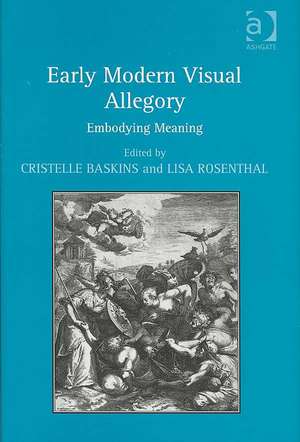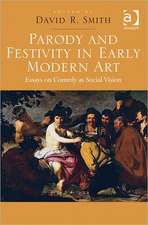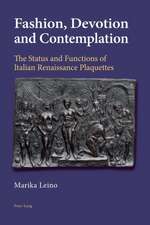Early Modern Visual Allegory: Embodying Meaning
Editat de Cristelle Baskins, Lisa Rosenthalen Limba Engleză Hardback – 27 sep 2007
| Toate formatele și edițiile | Preț | Express |
|---|---|---|
| Paperback (1) | 299.52 lei 6-8 săpt. | |
| Taylor & Francis – 9 oct 2017 | 299.52 lei 6-8 săpt. | |
| Hardback (1) | 826.65 lei 6-8 săpt. | |
| Taylor & Francis – 27 sep 2007 | 826.65 lei 6-8 săpt. |
Preț: 826.65 lei
Preț vechi: 1106.72 lei
-25% Nou
Puncte Express: 1240
Preț estimativ în valută:
158.18€ • 165.59$ • 130.88£
158.18€ • 165.59$ • 130.88£
Carte tipărită la comandă
Livrare economică 05-19 aprilie
Preluare comenzi: 021 569.72.76
Specificații
ISBN-13: 9780754657606
ISBN-10: 0754657604
Pagini: 316
Dimensiuni: 156 x 234 x 25 mm
Greutate: 0.83 kg
Ediția:1
Editura: Taylor & Francis
Colecția Routledge
Locul publicării:Oxford, United Kingdom
ISBN-10: 0754657604
Pagini: 316
Dimensiuni: 156 x 234 x 25 mm
Greutate: 0.83 kg
Ediția:1
Editura: Taylor & Francis
Colecția Routledge
Locul publicării:Oxford, United Kingdom
Cuprins
Contents: Introduction; Making Allegory: Giotto, de Man and the allegorical impulse in Michelangelo, Laura Camille Agoston; The ends of allegory: Winckelmann, rococo and volcanic displacement, Christiane Hertel; Allegories of race: casta paintings and models for theorizing race, Oscar E. Vázquez. Allegories of Place: Giorgione's Assault: war and rape in renaissance Venice, Paul H.D. Kaplan; Shaping civic personification: Pisa Sforzata, Pisa Salvata, Cristelle Baskins; Political allegories: redesigning Siena's palio and patron saint during the Fascist regime, Medina Lasansky. Allegory and Audience: The Devil's hem: allegorical reading in a 16th-century illustrated life of St Benedict, Evelyn Lincoln; The ideal prince or an allegorical dialogue between the City of Antwerp and the Court of Brussels, Margit Thøfner; The bellona factor: political allegories and the conflicting claims of martial imagery, Jane Kromm; Faveau's Dame Clémence, or personifying romanticism, Erica Naginski. Allegory as Carnal Knowledge: Venus's milk and the temptations of allegory in Otto van Veen's Allegory of Temptation, Lisa Rosenthal; The naked truth? The allegorical frontispiece and woman's ambition in 18th-century France, Mary Sheriff; Savage breast/salvaged breast: allegory, colonization and wet-nursing in Peru, 1532-1825, Carolyn Dean; Index.
Notă biografică
Cristelle Baskins is Associate Professor of Art History at Tufts University, USA.
Lisa Rosenthal is Associate Professor of Art History at the University of Illinois, Urbana-Champaign, USA.
Lisa Rosenthal is Associate Professor of Art History at the University of Illinois, Urbana-Champaign, USA.
Recenzii
’Each of the essays makes a valuable contribution to our thinking about the potential and the instability of allegory. The broad scope of these case studies, which span the sixteenth through the early twentieth centuries, counts among the strengths of the volume, as the reader is challenged to compare and reconsider the nature of visual allegories over nearly five centuries of the visual tradition in Europe, as well as in the New World. Not only do the essays remind us of the playfulness of allegory, but they also expand our appreciation of the broader visual culture that shaped both the making and the interpretation of allegorical images in the early modern era.’ Renaissance Quarterly
Descriere
The first book in twenty-five years devoted solely to early modern visual allegory, this anthology foregrounds new material, contextual and methodological questions. Considering a range of representations in the visual and material culture of Europe and the colonial "New World," contributors discuss processes and theories of interpretation, formation of audiences, reception history, appropriation and censorship. Particular focus on the body in visual allegory unites the volume's diverse materials and methods.



























